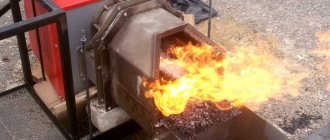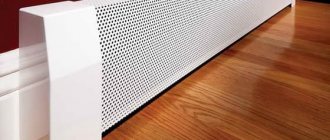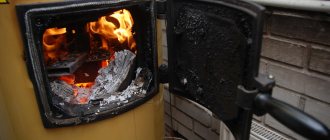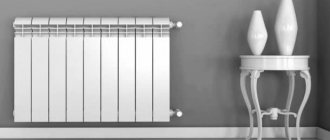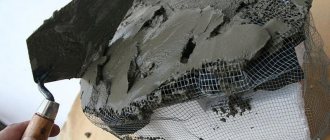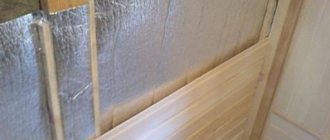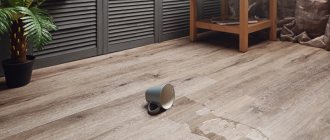Crushing foam may be necessary both to obtain foam chips for your own needs, and for the industrial production of material for sale. After all, crushed material is more expensive than whole material, which, moreover, is often thrown away after being used as protective packaging or insulation. The advantages of the crushing option are minimal investment and ease of assembly of the device. The main thing for this is to know how to make a crusher that will provide a productivity of 200 or more liters per hour. Also read: “Insulating concrete with polystyrene foam.”
The benefits of crushed polystyrene foam
You can stuff upholstered furniture with crushed polystyrene foam.
Polystyrene foam, which is an excellent heat insulator and is produced using the foaming process, is used in crushed form for the following work:
- roof construction;
- insulation of pipes for various purposes;
- leveling the cement surface;
- production of polystyrene concrete blocks;
- increasing the sound and heat insulation qualities of some building materials.
Crushed polystyrene foam is often used as a filler for frameless types of furniture - sofas, armchairs. You can find it inside toys and even pillows.
To make a roof vapor barrier with your own hands, you need to follow the installation technology correctly.
We talked about how to make a vapor barrier for walls in one of the previous articles.
If you need to get enough of this material at home, a foam crusher can easily be made yourself. To create it, regardless of the chosen option, you will need an electric motor with a low rotation speed, a housing and a container for collecting foam chips.
Types of foam shredders
You can choose the type of crusher for foam plastic based on the amount of material. If the main task is to obtain 1-2 small bags of crumbs, you may not need to assemble a special unit at all to complete it. It is enough to use a metal brush, which is used to rub sheets of foam insulation, or a homemade “grater” from a box with cells. This method will be ineffective, but will avoid costs.
It is better to immediately purchase high-quality material for roof vapor barrier than to redo all the work later.
The method for installing a vapor barrier on the floor is somewhat different from installing it on the roof.
If the amount of material is large enough and you need not 1 bag, but 10, 20 or more, you should decide how to make a crusher:
- using a mesh (production 0.2–0.3 cubic m/h). The most profitable and quickly implemented method;
- using an industrial crushing plant as an example (at least 1 cubic meter per hour). The equipment will be more expensive (although more profitable compared to buying a ready-made version) and will require more time to manufacture.
Mesh crusher
The simplest way to make a foam crusher with your own hands is to create a small grater machine, the design of which consists of:
- a round mesh element in the form of a disk;
- the shaft on which the mesh is installed;
- bases for mounting the motor and shaft. The engine can be taken, for example, from a concrete mixer, additionally installing a gearbox to reduce the speed (too fast rotation will lead to too small particles).
The foam is fed onto a rotating mesh, the size of the holes of which determines the diameter of the resulting granules. Feeding is carried out manually and requires preparation of the material - cutting it to the width of the disk. The advantage of this option is its low cost. The disadvantage is the difficulty of grinding all the pieces and a large amount of dust in the air. The first problem is solved by manual grinding (boxes and brushes), the second by using eye and respiratory protection.
Classic crusher
To increase the volume of production of foam granules, it is worth using the design of an industrial foam crusher, which you can purchase - but it is more profitable to make it yourself.
Industrial crusher knives.
In the production of foam chips, the material enters the shredder body towards two knives mounted on the drum and on the shaft. Getting between the cutting edges, the foam is crushed and produces granules of the desired size.
When manufactured independently, the shredder is assembled from a welded metal box, inside of which two shafts with long teeth rotate. They can be made, for example, by screwing ordinary screws into a wooden roller or by installing and securing rods in drilled holes.
You can earn good money in the production of foam chips with minimal investment.
The same low-power and low-speed engine is selected as the rotating device as for the crusher-grater. The result is particles with a diameter of several millimeters, which, if necessary, are refined manually. The principle of operation of such crushers is illustrated by photos of already manufactured ones.
Budget shredders made from scrap materials: do it yourself
Are you wondering where to put the grass that you mowed on the site, leaves, stems and tops? One option is to chop up the “free resource” and put it to use. For compost or food for small animals. For this you need a grass cutter. Don't want to overpay for a store-bought one? Make it yourself, inexpensively, as the users of the portal did.
- Homemade grass cutter “Monster” from an angle grinder and a galvanized tank
- Grass chopper and corn sheller with engine “Made in USSR”
- Features of the operation of homemade products and ways to improve them
Do-it-yourself grass cutter driven by an angle grinder
Tok2Z
User FORUMHOUSE
I have birch trees growing in my dacha. Leaves are falling from the trees. We have to clean it up, burn it, and fill up the compost pit. The foliage takes a long time to rot. I decided to chop it up. For this you need a grass cutter. I looked at what they were making on the Internet. I turned on my brain and this is what I came up with.
Do you like an inexpensive option for a garden shredder? Read the article further and find out how to make a homemade product from an angle grinder and a metal tank. Tok2Z
acted like this:
- He thought about how to twist the chopper blades. The choice is small - install a motor from a washing machine, or buy an electric motor. According to the user, the motor from the washing machine is weak, and I didn’t want to purchase a three-phase unit and convert it to one phase.
- Tok2Z
bought on the market, for 2 thousand rubles, an old grinder with a power of 2 kW and blades from a lawn mower for 700 rubles. I ordered an adapter sleeve from a turner, spending another 500 rubles. - I welded the frame and placed a galvanized water tank on it. I assembled the structure and turned on the grass cutter.
Tok2Z
The turnover is crazy. I threw a shovelful of leaves into the tank, and they blew away! I checked where the flow was going. Air goes up from the edge of the tank and is sucked in in the middle. I cut out a galvanized ring and installed it in the center of the tank. Threw the leaves. The knives crushed it just right, and it flew into the lower pipe.
To grind the grass into a very fine fraction, the user installed a corner in front of the “exhaust” pipe.
Pipe diameter 10 cm.
The grass cutter shreds the leaves directly into the compost bin.
Compare: a pile of leaves.
Shredded leaves.
Tok2Z
The grass cutter threshes everything - grass, leaves. Sometimes, along with the foliage, a wire comes across. Pebbles. Pieces of metal. The crusher crushes the stones. No iron. You have to turn it off, look for trash and throw it away. The noise is terrible. One of the disadvantages is the thin walls of the tank. It breaks through. I will redo it. I will make a tank from a sheet of iron 1-2 mm thick.
Universal grass cutter and corn sheller
Alex Nk
User FORUMHOUSE
I also made a grass cutter. I mainly use it to chop grass for poultry. The basis of the homemade product is a kilowatt motor made in the USSR. I bought it for 1400 rubles. Works great. The engine is three-phase, but converted to operate from a 220 Volt network.
Making a homemade grass cutter step by step:
- Holes were drilled and threaded in the flange.
- The knives were made from a piece of an old rusty two-handed saw.
- The knives were screwed to the flange.
- The grass cutter frame was made from a sheet of metal 4 mm thick. A strip of metal with a cross-section of 4x40 mm was welded to the square, which was bent in a circle. A hole was drilled in the center of the bed.
Alex Nk
I bent the strip with a hammer, striking the metal on the jaws of a vice. The radius was controlled in a circle by drawing it on the bed.
At the finish, the user welded the legs to the base. Fixed the electric motor. I made a large tank with a lid so that debris would not fly out of the grass cutter while the engine was running.
Homemade mobile grass cutter on wheels.
The tank is removable for ease of use of the grass chopper.
The engine produces 1500 rpm. The grass cutter operates almost silently.
Finished products.
Corn husker from grass cutter
Alex Nk
I decided to use a grass cutter to make a mechanism for shelling corn. The result is a two-in-one unit. To make a homemade product you need:
- Cut a disk out of metal.
- Drill holes in it for M6 bolts.
Tests have shown that the height of the hex head of conventional bolts is sufficient for shelling corn. The disc was raised from the base by 4 cm.
- Rework the base so that the outlet is at the bottom. This is how the grass is chopped finer, and the corn is not chopped.
The slope of the output tray has become steeper, almost vertical. This way the grass mass did not clog the hole.
- The disk was screwed to the flange.
Side view.
The tank has been redone. A “reflector” was attached to it to throw the corn “cobs” into the bucket.
Inside view.
Grass cutter-corn sheller assembled.
Finished products.
Places for storing fasteners.
To prevent the grass from wrapping around the motor shaft, the user installed a protection ring.
Disassembled grass cutter-corn sheller.
Alex Nk
I found experimentally that the optimal option for chopping grass is two knives. Four knives turn the grass into mush. I also threshed apples for the poultry. One bucket of apples is crushed in 4-5 minutes. The result is a grass cutter-vegetable cutter-fruit cutter.
conclusions
Properly configured production of foam chips can bring a certain profit. The main thing is to provide a sufficient amount of raw materials and resolve the packaging issue. The granules are distributed into bags and bags and stored until used or sold. At the same time, the cost of servicing a ready-made crusher is relatively small - the main costs fall on paying for electricity (when connected to the network) or purchasing fuel (when using diesel engines).
Crushing foam may be necessary both to obtain foam chips for your own needs, and for the industrial production of material for sale. After all, crushed material is more expensive than whole material, which, moreover, is often thrown away after being used as protective packaging or insulation. The advantages of the crushing option are minimal investment and ease of assembly of the device. The main thing for this is to know how to make a crusher that will provide a productivity of 200 or more liters per hour. Also read: “Insulating concrete with polystyrene foam.”
Use of recycled foam
Foam chips are used in industry and construction. It is made from recycled materials using different methods:
- Foaming polystyrene balls. The result is granules of a certain fraction.
- Shredding of household waste and production defects in crushers.
Crushed foam plastic raw materials are used as a filler for cement mortar in construction. It has proven itself well as a component when pouring screeds and leveling floors. Polystyrene concrete (lightweight concrete) is made from expanded polystyrene.
The benefits of crushed polystyrene foam
You can stuff upholstered furniture with crushed polystyrene foam.
Polystyrene foam, which is an excellent heat insulator and is produced using the foaming process, is used in crushed form for the following work:
- roof construction;
- insulation of pipes for various purposes;
- leveling the cement surface;
- production of polystyrene concrete blocks;
- increasing the sound and heat insulation qualities of some building materials.
Crushed polystyrene foam is often used as a filler for frameless types of furniture - sofas, armchairs. You can find it inside toys and even pillows.
To make a roof vapor barrier with your own hands, you need to follow the installation technology correctly.
We talked about how to make a vapor barrier for walls in one of the previous articles.
If you need to get enough of this material at home, a foam crusher can easily be made yourself. To create it, regardless of the chosen option, you will need an electric motor with a low rotation speed, a housing and a container for collecting foam chips.
Types of foam shredders
You can choose the type of crusher for foam plastic based on the amount of material. If the main task is to obtain 1-2 small bags of crumbs, you may not need to assemble a special unit at all to complete it. It is enough to use a metal brush, which is used to rub sheets of foam insulation, or a homemade “grater” from a box with cells. This method will be ineffective, but will avoid costs.
It is better to immediately purchase high-quality material for roof vapor barrier than to redo all the work later.
The method for installing a vapor barrier on the floor is somewhat different from installing it on the roof.
If the amount of material is large enough and you need not 1 bag, but 10, 20 or more, you should decide how to make a crusher:
- using a mesh (production 0.2–0.3 cubic m/h). The most profitable and quickly implemented method;
- using an industrial crushing plant as an example (at least 1 cubic meter per hour). The equipment will be more expensive (although more profitable compared to buying a ready-made version) and will require more time to manufacture.
Mesh crusher
The simplest way to make a foam crusher with your own hands is to create a small grater machine, the design of which consists of:
- a round mesh element in the form of a disk;
- the shaft on which the mesh is installed;
- bases for mounting the motor and shaft. The engine can be taken, for example, from a concrete mixer, additionally installing a gearbox to reduce the speed (too fast rotation will lead to too small particles).
The foam is fed onto a rotating mesh, the size of the holes of which determines the diameter of the resulting granules. Feeding is carried out manually and requires preparation of the material - cutting it to the width of the disk. The advantage of this option is its low cost. The disadvantage is the difficulty of grinding all the pieces and a large amount of dust in the air. The first problem is solved by manual grinding (boxes and brushes), the second by using eye and respiratory protection.
Classic crusher
To increase the volume of production of foam granules, it is worth using the design of an industrial foam crusher, which you can purchase - but it is more profitable to make it yourself.
Industrial crusher knives.
In the production of foam chips, the material enters the shredder body towards two knives mounted on the drum and on the shaft. Getting between the cutting edges, the foam is crushed and produces granules of the desired size.
When manufactured independently, the shredder is assembled from a welded metal box, inside of which two shafts with long teeth rotate. They can be made, for example, by screwing ordinary screws into a wooden roller or by installing and securing rods in drilled holes.
You can earn good money in the production of foam chips with minimal investment.
The same low-power and low-speed engine is selected as the rotating device as for the crusher-grater. The result is particles with a diameter of several millimeters, which, if necessary, are refined manually. The principle of operation of such crushers is illustrated by photos of already manufactured ones.
Do-it-yourself plastic crusher - drawing up a project and assembling homemade equipment
Plastic processing is one of the freest niches for doing business in Russia.
However, the issue of opening it most often depends on the cost of the equipment.
Entrepreneurs often start not with a full processing cycle with finished granulate at the output, but with the collection and grinding of polymer waste.
Even in this case, purchasing a shredder and/or crusher may not be affordable . One of the most discussed solutions to the problem is making your own shredder.
Such projects are quite feasible if two “constant quantities” are known - raw materials and product.
Next, we will talk about how to make a shredder and how to avoid gross mistakes when designing and making your own plastic crusher.
What is the difference between a shredder and a polymer crusher?
Both types of equipment perform the same task - crushing.
When processing plastics, this process is usually divided into two stages :
- coarse grinding - shredders are used for this;
- obtaining fine crumbs - a crusher is used for this.
The operating principle and kinematics of both units are most often the same, and they differ only in some details, for example, the size of the sieve cell, the overlap of the knives and the configuration of the cutting edges.
The process is divided into two stages in order to increase productivity and optimize energy costs.
Shredder design for plastics
When choosing the design of a plastic shredder, you should pay attention to the proposals of equipment manufacturers.
It is better to take other people’s work as a basis for a project and have certain guidelines than to reinvent the wheel and end up with a non-working model.
The most popular are single- and double-shaft rotary shredders.
Single-shaft
Single shaft shredders are used for the initial shredding of most varieties of polymers .
It consists of a rotor on which movable knives (2) are fixed and a housing with fixed or stator knives (1). The raw materials are fed through the loading window from above, and the finished crumbs are poured under their own weight through the calibrating sieve (3).
The shredding process involves repeated cutting and continues until all the plastic has gone into the receiving hopper.
The configuration of the rotary knives is selected depending on the material being processed:
- Dovetail and inclined – for processing film materials, PET containers and other soft waste.
- Straight – for crushing sprues, boxes, thick-walled blow moldings, PET bottle caps. Such knives are often made in the form of separate segments, which are arranged in cascades. Segmentation is performed to reduce shock loads on the drive, reduce noise and vibration.
Stator knives for single-shaft polymer crushers are made solid (type P).
Twin-shaft
The rotor and stator knives on such crushers are arranged in a checkerboard pattern, and the shafts rotate in counter directions.
Low-productivity machines with a small working chamber are made with a single drive ; the teeth on the rotary knives are used to capture and crush waste.
Grinding is also performed on the side surfaces (as in disc shears).
Where can I get the drawings?
You need to understand that manufacturers of equipment for shredders and crushers will not make drawings publicly available .
The easiest way to get diagrams for a homemade shredder or crusher is in two ways:
- Read forums on the topic , like this one. The likelihood of finding accurate and detailed drawings of plastic shredders is very low. Often, resource users recycle some unclaimed equipment from a related industry, for example, a lopper. And if a crusher is made from scratch, few people care about documenting all stages of production. Nevertheless, it’s worth reading the forums: analyzing discussions and other people’s design mistakes will help you make a more advanced plastic shredder with your own hands.
- Take measurements from the existing shredder. It will not be possible to obtain complete information, since the owner will not allow you to disassemble a working machine. But even a visual assessment will help in making your own homemade crusher.
Many attempts to make a crusher on their own reach a dead end due to the fact that the designer tries to attach to an existing unit . For example, “fit” all the elements to a worm gearbox found in the garage.
An attempt to reduce the cost of a design using secondary parts, as a rule, leads to mistakes.
Initial data for design
It is better to start production with a clear definition of the tasks of the shredder, that is, you need to know the type and quantity of raw materials being processed, and the size of the output fraction.
After this, we find a model from any well-known manufacturer that fits these parameters and take its technical characteristics :
- engine power;
- loading window dimensions;
- number and diameter of rotors;
- knife configuration.
Drafting
For example, we determined that a twin-shaft shredder with a low rotor speed is suitable for production tasks.
His project necessarily includes :
- engine selection by power;
- calculation of gear ratio and selection of factory model;
- determination of the diameter and length of the rotors (based on the size of the loading window);
- calculation of shafts for strength;
- selection of bearing supports.
To do this, you will need the textbook “Machine Parts” for universities. You will also have to look at GOSTs on threaded connections, reference books on gearboxes, bearings, couplings and other assembly units.
When using foreign-made inconsistencies often , for example, “their” retaining rings are thicker than “ours” with equal diameters.
This must be taken into account when assigning groove dimensions.
After the calculations, it is necessary to layout the components on graph paper or in an editor such as AutoCAD, determine the dimensions of the body parts and the frame.
You need to approach this task responsibly so as not to miss anything. Sometimes the protruding head of an “unaccounted for” bolt leads to the fact that the car has to be rebuilt . After this, detailing is done - a drawing of each part separately.
Drive design
In factory crushing plants, two methods are used to transmit rotation from the motor to the gearbox:
- Direct drive (via clutch). Torque transmission occurs without loss, the design is compact in size. If you manage to select a ready-made geared motor, the dimensions and weight of the installation will be even smaller. However, in this case, it is necessary to provide for manual (and ideally automatic) reversing in case of jamming of the rotors.
- Belting . Efficiency losses and relatively high dimensions are compensated by the smooth start of the mechanism. If the shredder becomes jammed, the only risk is that the belt will break or slip.
The transmission of rotation between the rotors (in the case of using one engine) is most often carried out through an open gear drive. When designing, you need to be prepared to calculate it. Most likely, gears will have to be ordered .
Knives
Finding a suitable knife configuration is not difficult.
Many manufacturers make no secret of this.
Anyone interested in the issue can choose a suitable profile and change the dimensions to fit their rotor, making the required number of teeth.
Knives will also have to be ordered from a company engaged in waterjet, plasma or laser cutting. Afterwards you will have to grind them to the same size along the plane.
The above also applies to fixed knives. Only for them you still have to think about how to attach them to the body.
Most often, counterknives are drilled with two through holes on the sidewalls and tightened with pins through spacer bushings.
Another pair of blind holes with threads are made on the side of the body for fastening to it with bolts.
Another important issue is the material. This can be one of the spring (65G, 60S2, 65S2VA) or die (X12MF) steels. In any case also have to order heat treatment with control of the hardness of each finished knife.
Shafts
The standard configuration for most manufacturers for fitting under knives is a hexagon . That is, the blank for the shaft can be a rolled profile , the ends of which are machined for bearings, gears, etc.
The optimal choice is steel 40, 45, 40X with improvement (hardening + high tempering).
Bearing units
You can use ready-made bearing units of a self-aligning design.
They “forgive” errors in the alignment of the holes, in which conventional radial bearings would warp and overheat .
However, compared to conventional bearings, the cost of such units is significantly higher .
In addition, the dimensions of their housings often do not allow maintaining the required center-to-axle distance between the rotors.
To avoid misalignment , the sides of the crusher body are used as axle boxes. The mounting holes are bored in a machine with a four-jaw spindle, placing the parts together.
If it is not possible to make a housing with coaxial holes, you can select double-row spherical bearings suitable for load-carrying capacity.
Rotors
One of the main requirements for rotors is the presence of a guaranteed gap between the sidewalls of the knives. Otherwise, they will rub against each other , and the mechanism may even jam.
The width of the spacer bushings should be larger. They also need to be sanded to the same size.
Particular attention should be paid to axial adjustment.
The design of the shafts must include the ability to shift the entire set of knives and bushings by tenths of a millimeter and securely fix it when the side clearance is uniform.
Most often, threaded parts are made on the shafts, and the position of the knives is fixed with nuts.
Assembly of finished units
In order for the design to be repairable, the body should not be welded .
It is better to make a bolted connection.
Then the chopper can be disassembled at any time for resharpening or replacing knives.
One of the common problems with rotating mechanisms is increased vibration.
To avoid this phenomenon, it is necessary to align the actuator, gearbox and motor, i.e., align their axes.
Another reason for vibration is imbalance (imbalance) of the rotors . To eliminate it, you need to carry out balancing.
We invite you to watch a video on how to implement the idea of a plastic recycling business using homemade equipment:
Conclusion
Not all the difficulties that will have to be encountered in the process of designing and assembling a plastic shredder have been considered
Manufacturing can only be called independent, since it requires a whole fleet of machines, and some units have to be purchased assembled. The whole process can take months , and financial investments will be required in any case.
After developing the project “on paper,” it is worth calculating the economic efficiency of the event : sum up the costs of procurement and processing, and then compare it with the price of a “factory” shredder.
Those who have already had experience in manufacturing shredders believe that the idea is justified in two cases: if there are no strict time restrictions or if it is planned to establish serial production of such units. For practical plastic recycling tasks, it is usually easier to choose a ready-made model .
conclusions
Properly configured production of foam chips can bring a certain profit. The main thing is to provide a sufficient amount of raw materials and resolve the packaging issue. The granules are distributed into bags and bags and stored until used or sold. At the same time, the cost of servicing a ready-made crusher is relatively small - the main costs fall on paying for electricity (when connected to the network) or purchasing fuel (when using diesel engines).
Recycled foam in a country house
Country construction is also not complete without this material. Fractions of different sizes are used to fill various irregularities or depressions in the area where construction is taking place. Of course, it cannot be used to level the road, but small uneven areas can be filled. It is convenient to fill holes, holes, and cavities with expanded polystyrene. After all, for many years, without changing, it remains in the place where it was located. It easily absorbs moisture and also releases it easily. Therefore, containers filled with foam plastic are less susceptible to corrosion.
The construction business has also found use for recycled polystyrene foam. It is from this that lightweight bricks are made, which are called perforated bricks because of their texture. At the suggestion of scientists, lightweight concrete appeared, which in its strength and durability is not inferior to the usual composition.
Expanded polystyrene also attracted the attention of designers. If we talk about processing at home, then here craftsmen are given wide scope for flight of imagination
Polystyrene foam melts well and quite quickly, so it is used to create designer items such as original flower pots or flowerpots. Using a special mold, hand-made craftsmen make beautiful, unique garden figurines, coasters for glasses, or even flower pots.
Foam cutting process
In order to cut foam plastic, you need:
- Turn on the power supply.
- Make high-quality markings on the foam sheet so that you can see where the cut line should be.
- Take a metal ruler and apply it to the cut line. Without a ruler it will be very difficult to cut.
- Cutting complex geometric shapes on such a machine is also possible, but for this you definitely need to practice on simple products.
Guide board
To make it easier to cut simple products and shapes, you can screw any flat board to the base of the cutter and use it as a guide. To do this you need:
- Find a flat board and place it on the base of the foam cutter.
- Drill a through hole at one end of the board. At the other end you need to make a slot in which the screw should move freely.
- Now all that remains is to set the desired size and screw both screws to the cutter itself. Thus, the board will serve as a guide against which the workpiece must be pressed. With its help you can cut products with a perfectly smooth edge.
Material cutting process
Why recycle?
The answer to this question is simple. The material accumulated over the years, which once served as packaging, trays, and decorative items, has nowhere to go. It cannot be burned as unnecessary wood products. This is due to the release of large amounts of toxic gases. There is nowhere to throw it away, and there is nowhere to recycle polystyrene foam.
The only sure way to get rid of such waste is to recycle polystyrene foam at home. In order to complete all work correctly and effectively, you must:
- Determine the purpose for which the processing is carried out.
- Choose a place where it will be convenient to process. This material not only flies, it is also perfectly electrified. Therefore, you may need a special room in which processing can be done.
- Choose a method of influencing the available foam waste.
Of course, first of all, you should think about the fact that this material can be useful as packaging material, but there are certain difficulties associated with its storage. In this case, it is crushed, but for this you need a foam crusher, but what to do next? Here everyone makes their own decision.
Methods of processing and use:
- Foam crusher. It can be crushed using a special crusher, but if one is not available, this is done manually. It is important to think through the process, because small particles of polystyrene foam are too light in weight and easily scatter in different directions. Therefore, when chopping polystyrene foam manually, it is placed in a bag or other container.
- Raw materials to be disposed of take up quite a lot of space and space. One of the most important tasks is to reduce its size. For this purpose, citrus zest concentrate is used (its second name is “lemon”). Under the influence of this substance, polystyrene foam not only becomes smaller, it turns into a liquid substance.
- Remelting can only be done by heating.
You can use crushed raw materials in your garden or in a country house. It is added to the soil in flower beds and mixed with soil in beds for growing greenery. This is due to the fact that granules help absorb and retain moisture in the soil, even in severe drought, preventing the soil from cracking. Both water and air penetrate the soil more easily, providing nutrition and ventilation to plant roots. But the properties of this material are such that there is no rotting in these soils.
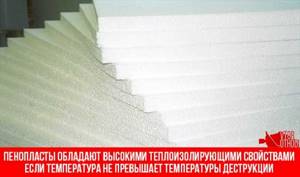
Do-it-yourself construction vacuum cleaner: differences from a household one and design features
The construction and renovation process is always accompanied by the appearance of a large amount of dust. A special device - a construction vacuum cleaner - will help you cope with it. You don’t have to buy it, but make it yourself at home. How industrial and country vacuum cleaners are created is described below.
It’s easy to make a construction vacuum cleaner with your own hands
What is the difference between a construction vacuum cleaner and a regular one?
Conventional household models cannot serve as an alternative to industrial ones. To make a construction vacuum cleaner with your own hands, you need to heavily rework the device. Otherwise, there is a risk of constant oversaturation of the dust collector. In addition, the device will quickly break down.
Note! For normal operation of the product, you need to use components that create a significant vacuum at the input. The vacuum device is driven by a powerful motor.
Design Features
Homemade construction vacuum cleaners are characterized by certain design features.
Construction vacuum cleaner with water filter
The principle of operation of a device with a water filter is that the air flow with dust moves in a spiral and touches the surface of the water. Thus, the system additionally humidifies the air. Due to this, the dust becomes heavier and settles into the water.
A vacuum cleaner with an aqua filter can also be replaced by an ordinary household bucket, to which you need to attach the appropriate attachments. A barrel of suitable size is also suitable for this purpose.
Homemade chip sucker
This device helps to collect shavings that are constantly lying under your feet. To achieve a good result, you need to take a motor with a long shaft and a sheet of plywood. The motor must be powerful enough and have a speed of up to 3000.
Plywood is used to make an impeller, which is similar to a water mill. To avoid beating, it must be properly balanced.
To assemble the device, you must do the following:
- install the side of the case;
- place the impeller on the shaft;
- mount the top;
- install the second side panel.
Note! An additional container is required to collect chips. An ordinary box or bag is suitable for this.
Construction vacuum cleaner for cement dust
How to make a vacuum cleaner to collect construction waste? To collect cement dust, you need to use several high-quality filters. The fact is that it is extremely difficult to retain small fragments. In addition, they easily absorb moisture, acquiring a sticky consistency.
To make a high-quality device, you need to combine water and cyclone types in one. Sometimes a vacuum cleaner is added to a wall chaser.
In any case, the device must include the following:
- plastic cone;
- capacity;
- household vacuum cleaner.
Important! A synthetic mesh must be placed on the surface of the water layer. It will prevent liquid from spilling during operation of the device.
The device can be used to collect cement dust
Garden device
People with their own gardens periodically have to remove leaves and other debris. Garden devices are used for this. It's easy to make them yourself.
It is recommended to use an old Soviet vacuum cleaner as a basis. You need to install a plastic container in it and connect a wide corrugation, which has a dense piece of pipe at the other end.
It is noteworthy that among compatriots it is not customary to collect leaves with a vacuum cleaner. However, those who have already tried this option are completely delighted. With the help of a simple device, the speed of cleaning in the garden increases significantly.
You can make an effective device for the garden
Operating principle of a construction vacuum cleaner
An industrial vacuum cleaner has a special operating principle. Its design includes a pump that allows you to create rarefied air. Its flow, along with the dirt, gets inside. Under the influence of filter systems, the air is purified.
In order for a construction vacuum cleaner with a cyclone to work correctly, it must have the following components:
Required tools and materials
To make a homemade device, it is recommended to take the following:
- simple household vacuum cleaner;
- plastic bucket;
- sewage pipe;
- polypropylene outlet;
- crown for metal.
Process of creation
Making homemade products depends on the available materials and tasks. In this case, different schemes can be used.
From improvised means
First of all, you need to make holes in the central part of the bucket lid and near the edge. Then you need to insert a tube into the center. However, first its edges must be processed with a file or sandpaper. This will help strengthen the adhesion of the surfaces. You should also prepare the lid. Then you need to lay the tube and apply glue.
When using a powerful vacuum cleaner, you should not use a plastic bucket, but a steel tank of a similar shape. Thanks to this, you don’t have to worry about the product being crushed.
From a household vacuum cleaner
Many craftsmen are interested in how to turn a regular vacuum cleaner into a construction one. To improve the properties of the device, you need to unscrew the wheels from it. Similar actions must be performed with the nameplate.
After removing all rivets and latches, you need to install the plug. To increase its reliability, it is necessary to wrap electrical tape and make a hole in the bottom. Its internal cross-section should be 3-4 cm. To seal the structure, you can use gaskets. You need to install a lid and a pipe in the waste container.
The cover must be secured with self-tapping screws. Then you can move on to working with the suction pipe. The hole into which it will be attached must be cut with metal scissors. Self-tapping screws can be used for fixation. To increase the tightness of the connection, gauze or a pharmaceutical bandage is suitable. Before winding, they should be soaked in glue.
An effective device can be made from a household vacuum cleaner
The effectiveness of homemade compared to store-bought analogues
Homemade devices cannot be compared with professional ones. They differ in the following parameters:
- motor and suction power;
- noise parameters;
- volume of waste collection container;
- air purification;
- additional functions;
- hull strength.
At the same time, a simple homemade vacuum cleaner will easily clean the room from small shavings and construction dust. Home devices are smaller in size. They help free the floor and walls from dust. However, they do not have an air purification function.
The manufacture of a construction vacuum cleaner has a number of features. To get a high-quality and reliable design, you should think it through to the smallest detail and prepare everything you need.
The principle of operation of a do-it-yourself foam crusher
This material is not disposed of like others, as it becomes harmful to nature and humans. When interacting with water, foam does not deteriorate or decompose, and it is prohibited to burn it due to the release of toxic gases. But it can be processed and implemented. This is the safest method of disposal. Just first you need to think everything through, calculate in detail and make a foam shredder with your own hands. Its waste bypasses all stages of crushing, and after that the crumbs are of fairly good quality.
Crushed foam is often used:
- in roof construction;
- as a bedding with shock-absorbing properties;
- when added to cement to level the surface;
- when insulating various types of pipes;
- when added to cement for sound and heat insulation;
- as a filler for upholstered furniture without a frame;
- in the production of polystyrene concrete blocks.
Crusher assembly diagram.
A foam shredder is quite easy to make if you want to. The main thing is that scrap foam is available at all times. In addition, a homemade foam crusher costs much less than one purchased in a store. To do this, you must have an electric motor with a low-speed engine so that the foam is crushed into individual balls.
In industrial production, it enters the crusher towards 2 knives, which are mounted on the drum wall and on the shaft. When rotating, the shaft passes through the axis of the steel drum. The material falls between the knives and is cut into separate parts. The foam particles fall onto a mesh with air for further sorting. From there, large parts go back under the knife.
Based on a production crusher, you can make your own shredder. But this structure is difficult to assemble and becomes a source of polystyrene dust. In addition, the resulting particles are about 2 cm in diameter. You can also make a simple crusher. It is performed according to the scheme of a simple mechanical grater.
Return to contents
Methods for cutting sheets
For this purpose, you can use various cutting tools, for example, a grinder, only then you should use the thinnest disk. Very often, builders use a simple sharp knife. Sometimes it is advised to use a hacksaw with very fine teeth, but the latter method is very questionable. In addition, stores sell special thermal knives designed for working with foam plastic.
The thermal knife heats up to 600 °C in just 10 seconds. However, this tool is quite expensive, so it doesn’t always make sense to buy it.

The way out in many cases will be a device for cutting foam sheets, made independently. It is probably somewhat cumbersome, but if you have the necessary components, it is absolutely free and always available. And if you have to do large-scale work, for example, you have ahead of you the insulation of a huge house that you built for your large family, then the question of how to conveniently cut the foam, and even a lot and quickly, will not come up throughout the entire event, no matter how small it is it took a long time.
The benefits of crushed polystyrene foam
You can stuff upholstered furniture with crushed polystyrene foam.
Polystyrene foam, which is an excellent heat insulator and is produced using the foaming process, is used in crushed form for the following work:
- roof construction;
- insulation of pipes for various purposes;
- leveling the cement surface;
- production of polystyrene concrete blocks;
- increasing the sound and heat insulation qualities of some building materials.
Crushed polystyrene foam is often used as a filler for frameless types of furniture - sofas, armchairs. You can find it inside toys and even pillows.
To make a roof vapor barrier with your own hands, you need to follow the installation technology correctly.
We talked about this in one of the previous articles.
If you need to get enough of this material at home, a foam crusher can easily be made yourself. To create it, regardless of the chosen option, you will need an electric motor with a low rotation speed, a housing and a container for collecting foam chips.
Use of recycled foam
Foam chips are used in industry and construction. It is made from recycled materials using different methods:
- Foaming polystyrene balls. The result is granules of a certain fraction.
- Shredding of household waste and production defects in crushers.
Crushed foam plastic raw materials are used as a filler for cement mortar in construction. It has proven itself well as a component when pouring screeds and leveling floors. Polystyrene concrete (lightweight concrete) is made from expanded polystyrene.
Of course, recycle it. To do this, first of all you need to buy a crusher for foam plastic.
Polystyrene foam is a unique material that can be used in a wide variety of ways. Moreover, it is not even necessary to build a factory or even organize a separate workshop for processing this material - just buy a regular crusher for foam plastic! And then... from crushed polystyrene foam you can make various containers, building materials, you can add it to the soil to improve its structure, fill various depressions and simply burn (the number of calories released when burning polystyrene foam is the same as when burning gasoline).
Buying a high-quality crusher for foam plastic is a profitable solution. Foam shredders are designed specifically for processing lightweight materials. Maintenance and repair work are inexpensive - replacement of parts is rarely required, in addition, foam crushers consume quite little electricity.
From us you can buy a high-quality foam crusher at competitive prices. We offer only high-quality equipment! Call, ask - and buy! It's profitable!
We suggest you buy equipment such as a foam plastic waste crusher , the advantages of which include the use of lightweight materials that cannot be processed using other equipment. Equipment for processing foam plastic is equipped with knives that have double-sided sharpening, and the crumbs come out thanks to centrifugal forces.
The foam plastic waste crusher is a universal equipment, since it can compress waste such as foam rubber, synthetic padding, etc. The motor in the designs of our crushers is located outside the frame. This design reduces the shock load on the engine. We always have equipment for processing polystyrene foam in stock.
We deliver throughout Russia. The warranty service for the machines is 1 year. Our clients can take advantage of a flexible system of discounts! Also read interesting and useful articles Press machine here and Foam shredder here.
Why is it convenient to use crushers?
The impact crusher for polystyrene stands out among other devices with the following advantages:
- During operation, little dust is generated. This improves the sintering of blocks when processing polystyrene foam and new granules.
- In an impact crusher, balls are separated, rather than cutting, as in other types of devices.
- A large reserve of equipment strength significantly increases the uninterrupted operation of the entire line.
- Processes polystyrene of any grade - both heavy and light.
- The design and operation of the impact crusher is very simple. You can maintain it yourself and without large investments.
The main elements of a foam crusher are:
- handle on the damper;
- bunker;
- tank for loading primary material;
- the basis;
- casing with electric motor.
The crushing chamber of the equipment is a structure consisting of a metal body, a cutting surface (knife), a mesh and a base. To set the distance between the rollers of the device, an adjustment mechanism with a spring is used.
The material is placed in a tank, from where it is supplied to the working body for grinding. Due to the rotation of the shaft through drum axes, grinding occurs when foam reaches the cutting elements. It passes through cutters and is crushed into fractions of the required size. The recycled material then falls into an air mesh for subsequent sorting. Large elements that do not pass through the mesh are returned to the grinding chamber and undergo a repeated grinding process. The foam that has passed through the mesh cells ends up in the dispensing department in the form of a finished crushed product.
AMD-600DU for foam crushing
Model with improved engine placement. In order to reduce shock loads, it is placed on the frame. Additionally, a belt drive mechanism is involved. It has a productivity of 80-120 kg/h, due to the engine power (11 kW) and rotor speed (1500 rpm). The equipment has optimal dimensions and weighs 250 kg. Reliable when processing polystyrene foam. Suitable for production of building materials, packaging and sorting departments of household appliances, shops, warehouses.
Denisov Denis Anatolievich
Our crushers meet European quality standards, comply with current GOSTs, and have a long service life. AMD Plast is your faithful friend and responsible supplier. An impeccable reputation and rich experience, excellent service and many years of experience in the Russian and international markets make us the most suitable partner. Still have questions? Call!
Why is it convenient to use crushers?
The impact crusher for polystyrene stands out among other devices with the following advantages:
- During operation, little dust is generated. This improves the sintering of blocks when processing polystyrene foam and new granules.
- In an impact crusher, balls are separated, rather than cutting, as in other types of devices.
- A large reserve of equipment strength significantly increases the uninterrupted operation of the entire line.
- Processes polystyrene of any grade - both heavy and light.
- The design and operation of the impact crusher is very simple. You can maintain it yourself and without large investments.
The main elements of a foam crusher are:
- handle on the damper;
- bunker;
- tank for loading primary material;
- the basis;
- casing with electric motor.
The crushing chamber of the equipment is a structure consisting of a metal body, a cutting surface (knife), a mesh and a base. To set the distance between the rollers of the device, an adjustment mechanism with a spring is used.
The material is placed in a tank, from where it is supplied to the working body for grinding. Due to the rotation of the shaft through drum axes, grinding occurs when foam reaches the cutting elements. It passes through cutters and is crushed into fractions of the required size. The recycled material then falls into an air mesh for subsequent sorting. Large elements that do not pass through the mesh are returned to the grinding chamber and undergo a repeated grinding process. The foam that has passed through the mesh cells ends up in the dispensing department in the form of a finished crushed product.
To make a shredder with your own hands, you need
Shaft crusher diagram.
- round mesh disc;
- drive shaft for securing the disk;
- the base where the drive shaft will be attached;
- guide plane for feeding foam sheets.
The shredder design is:
- The grater is directly attached to the shaft and rotates simultaneously with it. The shaft is driven by any engine through a gearbox, which reduces the number of shaft revolutions.
- The pieces of foam plastic are fed through a guide pipe onto the grater.
- The gap between the cutting elements and the hole in the grater determines the size of the foam particles at the outlet.
If you place such a crusher indoors and install a dust collector on the machine’s engine with your own hands, you can do without a protective-collecting casing around the shaft and forced suction of fine material.
A homemade crusher has its drawbacks:
- dust in the room;
- a large number of uncut pieces.
For the remaining large pieces, a kind of manual chopper is used. In this case, the foam crusher is an ordinary plastic box designed for transporting and storing vegetables and fruits. Pieces of foam plastic are simply rubbed along the bottom of the box using forward-return movements like a vegetable grater.
A do-it-yourself crusher can bring significant income to its owners if properly configured for processing the material and its further sale
It is important here that the source material, polystyrene foam, is always available for processing, and that all conditions are created for weighing and packaging the granules into plastic bags.
Most popular blog articles of the week
- Making a homemade wood-burning boiler
- How to calculate thermal energy for heating?
- Comparative characteristics of heating radiators
- The heated towel rail does not work: causes of failure and possibility of repair
- Features of heating types for a country house
- How to choose the right gas heating boiler model
- DIY Dutch oven construction
Features of the foam cutting process
Foam is a foam material and is mostly air, so it is very light and easy to work with. However, you should not think that no problems arise, because besides everything, foam is a rather fragile material. Therefore, if you use an electric grinder, you shouldn’t expect smooth edges, and besides, the entire room and area will be strewn with crumbled foam.
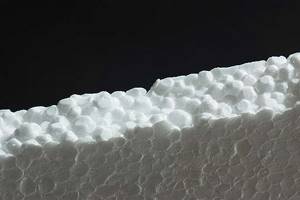
No matter how sharp the knife is, the material will still crumble. Of course, this is a minor defect and the sheets will be suitable for use, but cleaning will turn into a troublesome task. There is a way out of this situation; you can use a thermal knife. In this case, the edges of the material are melted and it does not crumble. But bad luck, such a device costs a lot, but in principle you can heat an ordinary knife. However, in this case you need to be very careful so as not to get burned, and the work will be significantly delayed.

Types of foam shredders
You can choose the type of crusher for foam plastic based on the amount of material. If the main task is to obtain 1-2 small bags of crumbs, you may not need to assemble a special unit at all to complete it. It is enough to use a metal brush, which is used to rub sheets of foam insulation, or a homemade “grater” from a box with cells. This method will be ineffective, but will avoid costs.
It is better to immediately purchase high-quality material for roof vapor barrier than to redo all the work later.
The technique is somewhat different from roof installation.
If the amount of material is large enough and you need not 1 bag, but 10, 20 or more, you should decide how to make a crusher:
- using a mesh (production 0.2–0.3 cubic m/h). The most profitable and quickly implemented method;
- using an industrial crushing plant as an example (at least 1 cubic meter per hour). The equipment will be more expensive (although more profitable compared to buying a ready-made version) and will require more time to manufacture.
Mesh crusher
The simplest way to make a foam crusher with your own hands is to create a small grater machine, the design of which consists of:
- a round mesh element in the form of a disk;
- the shaft on which the mesh is installed;
- bases for mounting the motor and shaft. The engine can be taken, for example, from a concrete mixer, additionally installing a gearbox to reduce the speed (too fast rotation will lead to too small particles).
The foam is fed onto a rotating mesh, the size of the holes of which determines the diameter of the resulting granules. Feeding is carried out manually and requires preparation of the material - cutting it to the width of the disk. The advantage of this option is its low cost. The disadvantage is the difficulty of grinding all the pieces and a large amount of dust in the air. The first problem is solved by manual grinding (boxes and brushes), the second by using eye and respiratory protection.
Classic crusher
To increase the volume of production of foam granules, it is worth using the design of an industrial foam crusher, which you can purchase - but it is more profitable to make it yourself.
Industrial crusher knives.
In the production of foam chips, the material enters the shredder body towards two knives mounted on the drum and on the shaft. Getting between the cutting edges, the foam is crushed and produces granules of the desired size.
When manufactured independently, the shredder is assembled from a welded metal box, inside of which two shafts with long teeth rotate. They can be made, for example, by screwing ordinary screws into a wooden roller or by installing and securing rods in drilled holes.
You can earn good money in the production of foam chips with minimal investment.
The same low-power and low-speed engine is selected as the rotating device as for the crusher-grater. The result is particles with a diameter of several millimeters, which, if necessary, are refined manually. The principle of operation of such crushers is illustrated by photos of already manufactured ones.
Video about making a crusher
To produce foam chips in artisanal conditions, you can make a crusher that works on the principle of a mechanical grater for vegetables. When assembling the crusher yourself, you use a welded metal box, inside of which two shafts with long teeth are mounted.
To make them, you will need two pieces of pipe, 50 cm long, 50 mm in diameter, with a wall thickness of 2.5 mm made of polyethylene. Wooden blocks are placed inside and adjusted to the size of the inside of the pipes.


